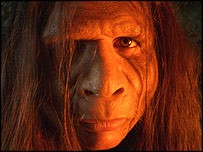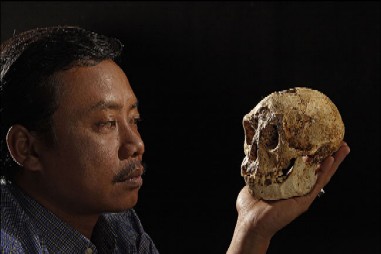
While people can debate the reality of giant hairy Johor Hominids, huge hirsute Canadian Sasquatch, or little furry Hawaiian Menehunes, there’s no denying the continuing and expanding picture of the reality of the tiny, three-feet tall human-like beings of Indonesia.
We have their bones.
In a new, just-published July 2006 paper in the Journal of Human Evolution, scientists have confirmed that the so-called "Hobbits" of Flores, Indonesia, are a separate species. (Please read here for other Cryptomundo revelations about these real-life little hominids and their contemporary sightings.)

Yesterday, USA Today’s Dan Vergano summarized the results:
Now a study accepted for publication by the Journal of Human Evolution wades into the dispute and suggests that Homo floresiensis is a new species, but that its link to human relatives, the Homo genus, is not so certain. Led by Debbie Argue of the Australian National University in Canberra, the study looks at microencephalic skulls found elsewhere by archaeologists and then looks at the rest of the bones.
The description of LB1, and bits and pieces of seven or eight more besides, noted a lot of curiosities about these creatures. They are a "curious mosaic" of features, according to [discoverer Mike] Morwood. The skull bears a mix of features, rounded eye sockets for example, that look like human ancestors. Others, like an almost non-existent chin, look very "primitive." Similarly the creature’s leg bones look primitive as well, Argue and colleagues say, most closely resembling an ancient (2-million or so year-old) ape relative called Australopithecus garhi from Africa.
Based on the analysis of microencephalic skulls, the team rules out the most likely form of microencephaly for LB1. But the rest of the bones are too big a mix to come to a definite conclusion about the ancestry of the hobbits, other than to say, judging by their "primitive" features, they must have spent a long time on Flores, say two million years, even further back than Homo erectus. How hobbits got there is another mystery. But "it’s attribution to a new species, Homo floresiensis, is supported," they conclude, even if we don’t quite know what they are.
"The results of analyses completed and still in progress, strongly suggest that the ancestral lineage for H. floresiensis in Asia harks back to very early in the evolutionary history of genus Homo," says Morwood, by e-mail, adding that his team is about to return to Flores for further excavations.

Here’s the abstract of the new paper:
"Homo floresiensis: Microcephalic, pygmoid, Australopithecus, or Homo?"
Journal of Human Evolution
by Debbie Argue, Denise Donlon, Colin Groves and Richard Wright
Abstract
The remarkable partial adult skeleton (LB1) excavated from Liang Bua cave on the island of Flores, Indonesia, has been attributed to a new species, Homo floresiensis, based upon a unique mosaic of primitive and derived features compared to any other hominin. The announcement precipitated widespread interest, and attention quickly focused on its possible affinities. LB1 is a small-bodied hominin with an endocranial volume of 380–410 cm3, a stature of 1 m, and an approximate geological age of 18,000 years. The describers (Brown et al., 2004) originally proposed that H. floresiensis was the end product of a long period of isolation of H. erectus or early Homo on a small island, a process known as insular dwarfism. More recently, Morwood, Brown, and colleagues (2005) reviewed this assessment in light of new material from the site and concluded that H. floresiensis is not likely to be descended from H. erectus, with the genealogy of the species remaining uncertain. Other interpretations, namely that LB1 is a pygmy or afflicted with microcephaly, have also been put forward.
We explore the affinities of LB1 using cranial and postcranial metric and nonmetric analyses. LB1 is compared to early Homo, two microcephalic humans, a ‘pygmoid’ excavated from another cave on Flores, H. sapiens (including African pygmies and Andaman Islanders), Australopithecus, and Paranthropus. Based on these comparisons, we conclude that it is unlikely that LB1 is a microcephalic human, and it cannot be attributed to any known species. Its attribution to a new species, Homo floresiensis, is supported.
Follow CryptoZooNews
Not Found
The resource could not be found.